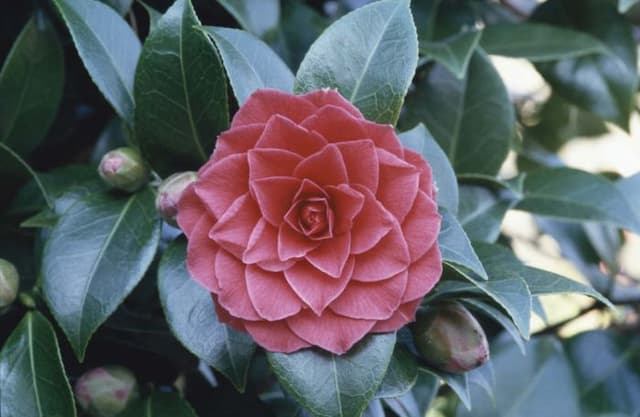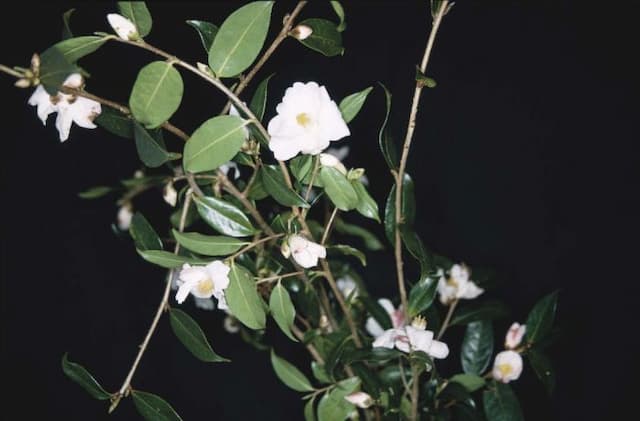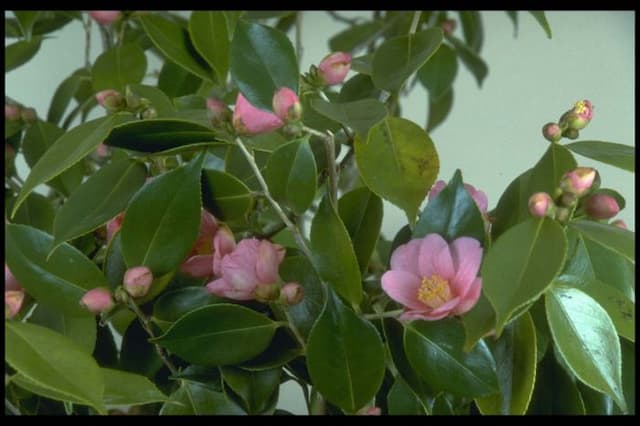Williamsii Camellia Camellia × williamsii 'Muskoka'

ABOUT
The Camellia 'Muskoka' is a visually striking shrub, notable for its glossy, evergreen leaves that provide a lush backdrop to its remarkable flowers. The leaves are dark green with a leathery texture and have a slightly serrated edge, lending a refined look to the plant. The real show-stoppers, however, are the blooms, which can appear from late winter through early spring, adding color to the garden when few other plants are in flower. The flowers of the 'Muskoka' variety are large and often resemble the peony form, presenting a luxurious display of layered petals. They may come in shades ranging from white to pink to red, and they sometimes exhibit attractive streaks or speckles, creating a truly eye-catching pattern. The blooms are often contrasted with bright yellow stamens at their center, which add an additional pop of color and attract pollinating insects. Despite the exclusion of its specific dimensions, the overall growth habit of the 'Muskoka' camellia is such that it often forms a dense, rounded shrub. This makes it a versatile choice for gardeners, as it can serve as a focal plant, a hedge, or a background plant for a mixed border. The plant is also valued for its ability to bring a touch of elegance to the landscape, with its combination of striking foliage and romantic, showy blossoms.
About this plant
 Names
NamesFamily
Theaceae.
Synonyms
Williamsii Camellia, Hybrid Camellia, Muskoka Camellia.
Common names
Camellia × williamsii 'Muskoka'.
 Toxicity
ToxicityTo humans
Williamsii camellia plants are not considered toxic to humans. Therefore, there are no symptoms associated with poisoning because ingestion of this plant typically does not lead to any adverse health consequences for humans.
To pets
Williamsii camellia is also generally considered non-toxic to pets. There should be no symptoms of poisoning since this plant is not known to cause any harm if ingested by pets. Consequently, ingestion should not result in any significant health issues.
 Characteristics
CharacteristicsLife cycle
Perennials
Foliage type
Evergreen
Color of leaves
Green
Flower color
Pink
Height
6-10 feet (1.8-3 meters)
Spread
5-8 feet (1.5-2.4 meters)
Plant type
Shrub
Hardiness zones
7
Native area
Asia
Benefits
 General Benefits
General Benefits- Ornamental Value: Adds aesthetic appeal to gardens with its attractive flowers and evergreen foliage.
- Low Maintenance: Requires minimal pruning and care once established, making it suitable for busy gardeners.
- Seasonal Interest: Provides vibrant color in the spring when the flowers bloom.
- Drought Resistance: Once established, it can tolerate periods of dry weather.
- Pest Resistance: Generally resistant to many pests, reducing the need for chemical treatments.
- Cold Hardiness: Capable of withstanding cooler temperatures, suitable for a variety of climates.
- Longevity: Can live for many years with proper care, providing lasting enjoyment.
- Adaptability: Able to grow in a range of soil types, although preferring well-drained, acidic conditions.
- Wildlife Attraction: Can attract pollinators like bees which are beneficial for the garden ecosystem.
- Privacy: When planted in groups, it can act as a natural privacy screen.
 Medical Properties
Medical PropertiesThis plant is not used for medical purposes.
 Air-purifying Qualities
Air-purifying QualitiesThis plant is not specifically known for air purifying qualities.
 Other Uses
Other Uses- The leaves of Camellia can be used as a natural dye for fabrics, providing a range of colors depending on the mordant used.
- Dried Camellia petals can be added to potpourri mixtures for their fragrance and to enhance the visual appeal of the mix.
- Camellia petals are sometimes used to decorate cakes and desserts as an edible garnish, adding a touch of elegance.
- The wood of Camellia plants is hard and can be used in woodworking for the creation of small objects, such as handles and inlays.
- Cold-pressed oil extracted from Camellia seeds, though primarily used for skincare, can also be used to condition and protect leather goods.
- Camellia blossoms can be floated in bowls of water as a simple yet sophisticated decorative element for event centerpieces.
- Fallen Camellia flowers can be collected and used as a natural mulch, providing nutrients as they decompose in the garden.
- Pressed or dried Camellia flowers can be included in handmade paper, adding texture and visual interest to the finished product.
- An infusion of Camellia petals can serve as a gentle color wash for artwork, imparting a subtle hue to paper or canvas.
- Camellia blooms can be used in photography, especially macro photography, as a subject to explore intricate details and patterns.
Interesting Facts
 Feng Shui
Feng ShuiThe Camellia is not used in Feng Shui practice.
 Zodiac Sign Compitability
Zodiac Sign CompitabilityThe Camellia is not used in astrology practice.
 Plant Symbolism
Plant Symbolism- Admiration: The camellia blossom is often associated with deep respect and admiration, making it the perfect gift to show someone that you look up to them or highly value what they represent.
- Perfection: With its luscious petals and flawless appearance, the camellia symbolizes the ideal or perfection, often used to celebrate the impeccable nature of someone's character or beauty.
- Long-lasting Affection: The longevity of the camellia flower, as it blooms throughout several seasons, represents the enduring nature of love and affection, suggesting a love that withstands the test of time.
- Gratitude: Presenting camellias can express gratitude, often used in ceremonies or gifts as a way of saying thank you for good deeds or friendship.
 Water
WaterWilliamsii camellias should be watered thoroughly to ensure the root ball is moist, particularly during the first couple of years after planting and during dry periods. They prefer consistently moist soil, so it's best to check the top inch of the soil weekly and water when it feels dry. Williamsii camellias typically require 1 to 1.5 gallons of water per week, depending on the size of the plant and the weather conditions. Avoid letting the soil get soggy or waterlogged, as this can lead to root rot. During the winter months, when the plant is not actively growing, reduce the frequency of watering.
 Light
LightWilliamsii camellias thrive in partial shade with some morning sun and afternoon shade or light, dappled sunlight throughout the day. They should be protected from intense midday sun, which can scorch their leaves. The best spot for a Williamsii camellia is an east-facing or north-facing position where they receive bright but indirect light.
 Temperature
TemperatureWilliamsii camellias prefer a temperate climate with temperatures ranging between 40 to 85 degrees Fahrenheit. They can survive brief periods of temperatures just above freezing, but prolonged exposure to freezing temperatures below 20 degrees Fahrenheit can damage the plant. The ideal temperature for thriving Williamsii camellias would be between 60 to 70 degrees Fahrenheit.
 Pruning
PruningPrune Williamsii camellias to maintain shape and promote bushier growth, remove any dead or weak wood, and enhance air circulation within the plant. The best time for pruning is just after the camellias have finished blooming, usually in late winter or early spring. Pruning at this time ensures that you won't cut off next year's buds, which form on the current year's growth.
 Cleaning
CleaningAs needed
 Soil
SoilWilliamsii camellias require acidic soil with a pH between 5.5 and 6.5. A good soil mix consists of equal parts of pine bark, peat moss, and perlite or sand for drainage. Regularly check pH and adjust as necessary for optimal growth.
 Repotting
RepottingWilliamsii camellias should be repotted every 2-3 years. It's best done in late winter or early spring before the growing season starts, to give the plant time to establish in its new container.
 Humidity & Misting
Humidity & MistingCamellia × williamsii 'Muskoka' does best in moderate to high humidity levels, around 40-60%. Avoid placing it near heating vents or air conditioners that can dry out the air.
 Suitable locations
Suitable locationsIndoor
Ensure bright, indirect light and high humidity for Williamsii camellias indoors.
Outdoor
Plant in partial shade with shelter from strong winds for outdoor Williamsii camellias.
Hardiness zone
7-9 USDA
 Life cycle
Life cycleThe life cycle of Camellia × williamsii 'Muskoka', commonly known as Williamsii camellia, begins with seed germination which occurs in a warm, moist environment, typically after a period of stratification to break dormancy. Upon germination, the seedling stage is characterized by the growth of the first roots and shoots as the plant establishes itself. As the plant enters the vegetative stage, it develops a robust root system and foliage, maturing over several years into a sizable shrub. The transition to the reproductive stage is marked by the emergence of buds that eventually open to reveal large, ornamental flowers, usually during late winter to early spring. After pollination, often by insects, the plant produces seed pods that, once mature, release seeds to complete the cycle. Throughout its life, the Williamsii camellia undergoes annual cycles of growth, flowering, and dormancy, typically with a lifespan that can reach several decades under optimal conditions.
 Propogation
PropogationPropogation time
Spring-Early Summer
Propogation: Camellia × williamsii 'Muskoka', commonly known as Camellia, can be propagated effectively through semi-hardwood cuttings. This method is widely practiced in the late summer when the current year's growth has begun to mature. Cuttings of about 4 to 6 inches (10 to 15 centimeters) length are snipped just below a leaf node, and then the lower leaves are removed. The cut end is often treated with a rooting hormone to encourage root development and then planted in a pot filled with a mix of peat and perlite or a similar well-draining medium. The pot is kept in a humid environment, shaded from direct sunlight, and maintained with consistent moisture to foster root growth. It usually takes several weeks to a few months for the cuttings to root effectively before they can be transplanted.









